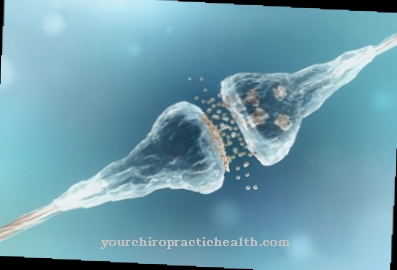The Hormone production is localized in different places in the body. The endocrine system includes organs that produce hormones such as the pineal, thyroid, parathyroid, pituitary, thymus, pancreas, ovaries, testes and adrenal glands.
What is hormone production?

Most of the hormone production takes place in the endocrine organs. Most of the hormones are made in the pituitary, hypothalamus and adrenal glands. But the epiphysis (pineal gland), the parathyroid glands and the islets of Langerhans of the pancreas also produce vital hormones.
The endocrine glands also include the Leydig cells in the testes, the corpus luteum and the cells of the heart that produce the atrial natriuretic peptide (ANP). Hormones are even formed in organs that are not actually part of the endocrine system. A large number of digestive hormones are produced in the stomach or intestines, for example.
Depending on the hormone, different starting substances are required for production. Glucocorticoids, mineralocorticoids, and sex hormones are made from steroids. The thyroid hormones T3 and T4 are based on iodine compounds. Adrenaline, noradrenaline, histamine, serotonin and melatonin are made from amino acids. All releasing and inhibiting hormones, the antidiuretic hormone (ADH), FSH, ACTH, LH, insulin, gastrin, parathyroid hormone and erythropoietin consist of peptides and proteins. Eicosanoids are the basis of prostaglandins and leukotrienes.
Function & task
The superordinate organ in hormone production is the hypothalamus. It produces eight essential hormones. With the thyrotropin releasing hormone (TRH) the hypothalamus regulates the thyroid activity via the pituitary gland.When the TRH level is high, the pituitary gland produces thyroid stimulating hormone (TSH). This has a stimulating effect on thyroid growth and stimulates the release of the thyroid hormones T3 and T4. T3 and T4 are produced by the follicular epithelial cells. For this, the cells need iodine. In the body, the thyroid hormones then mobilize energy and stimulate the metabolism.
The corticotropin releasing hormone (CRH) is also produced in the hypothalamus. In the anterior pituitary gland, it is responsible for the release of the hormone ACTH. ACTH, the adrenocorticotropic hormone, is made up of 39 amino acids. It reaches the adrenal cortex via the bloodstream, where it stimulates the production of glucocorticoids. Glucocorticoids belong to the group of steroid hormones. The starting substance is cholesterol, which either comes from food or is synthesized by the liver. Cortisol is then produced via the intermediate stages pregnenolone, progesterone, hydroxyprogesterone and deoxycortisol.
The production of glucocorticoids is subject to circadian fluctuations. Hardly any glucocorticoids are produced during sleep; the production maximum is reached in the early morning hours. Glucocorticoids like cortisol stimulate glucose production and fat mobilization. At the same time, they inhibit the secretion of insulin. Insulin is produced in the beta cells of the pancreas. Production is particularly stimulated by food intake. After eating, the insulin level in the blood rises, so that more glucose can be transported from the blood into the cells.
Another hormone that is produced in the hypothalamus is the gonadotropin releasing hormone (GnRH). It stimulates the production and secretion of two gonadotropins in the anterior pituitary gland. On the one hand, FSH is increasingly being synthesized. FSH is the follicle stimulating hormone. It reaches the gonads via the bloodstream. LH, the luteinizing hormone, also affects the ovaries and testicles. In men, LH stimulates testosterone production. In women, LH stimulates the production of estrogens in the ovaries.
Illnesses & ailments
During hormone production, disorders can arise in the various endocrine organs, which can cause a wide range of symptoms. Most of the time, hormone production in the subordinate endocrine organs is disturbed. Benign or malignant diseases of the hypothalamus or pituitary gland rarely interfere with hormone production. Pituitary tumors can be hormone-active or hormone-inactive. The most common pituitary tumor is the prolactinoma. It is a tumor that produces the hormone prolactin. Conversely, the hormone production can also be restricted by the tumor, so that there is, for example, a growth hormone deficiency. This manifests itself through increased fat deposits on the stomach, through an increased risk of osteoporosis or through a decrease in muscle mass. If the pituitary gland stops producing TSH, an underactive thyroid develops with symptoms such as tiredness, fatigue, cold intolerance, constipation and hair loss.
Disruption of hormone production in the adrenal gland also has drastic effects. The so-called Addison crisis leads to a complete loss of production. The Addison crisis usually develops out of Addison's disease. The sudden drop in hormone levels causes severe cardiovascular disorders that can lead to a coma. If the Addison Crisis is dealt with too late, it can be fatal.
With Cushing's disease, the problem is not a lack of hormone production, but an excessive production. In Cushing's disease, a pituitary gland tumor produces too much ACTH. As a result, the adrenal cortex synthesizes too much cortisol. The disease is therefore also known as hypercortisolism. Typical symptoms of Cushing's syndrome are trunk obesity, weight gain, a round moon face, a decrease in muscle mass, increased blood pressure, impotence and, in children, growth disorders or obesity.
If the pituitary gland produces too little antidiuretic hormone, this results in diabetes insipidus. Patients can no longer retain water in their bodies and excrete up to 20 liters of urine every day. They are constantly thirsty and drink large amounts. In Schwartz-Bartter syndrome, the pituitary gland produces significantly too much ADH. The electrolyte changes lead to loss of appetite, vomiting, diarrhea, muscle cramps and nausea. The causes of Schwartz-Bartter syndrome are trauma, inflammation of the brain or severe burns. Pneumonia can also cause this syndrome.








.jpg)



















